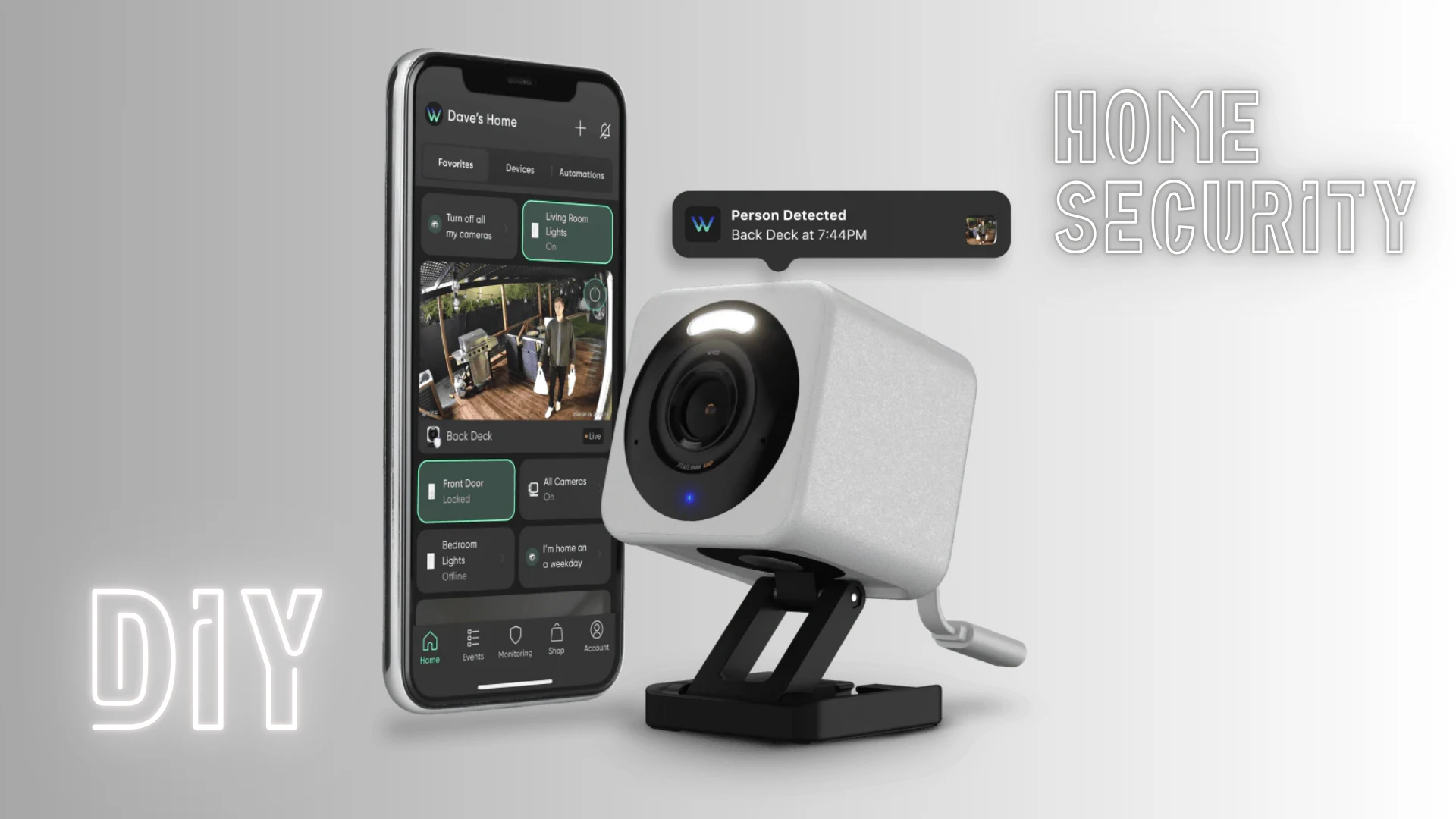Photo credit: Wyze, TechNovus Lens
Remember that feeling when you leave for vacation, and a tiny voice in the back of your head whispers, “Did I lock the door?” Imagine silencing that voice and knowing what’s happening at home, all without breaking the bank or signing a long-term contract. That’s the promise of a DIY home security system. But with so many options out there, how do you know which one is right for you? And is DIY monitoring really as good as the pros? In this guide, we’ll break it all down, so you can make the best decision for your home and budget.
Why Choose a DIY Home Security System?
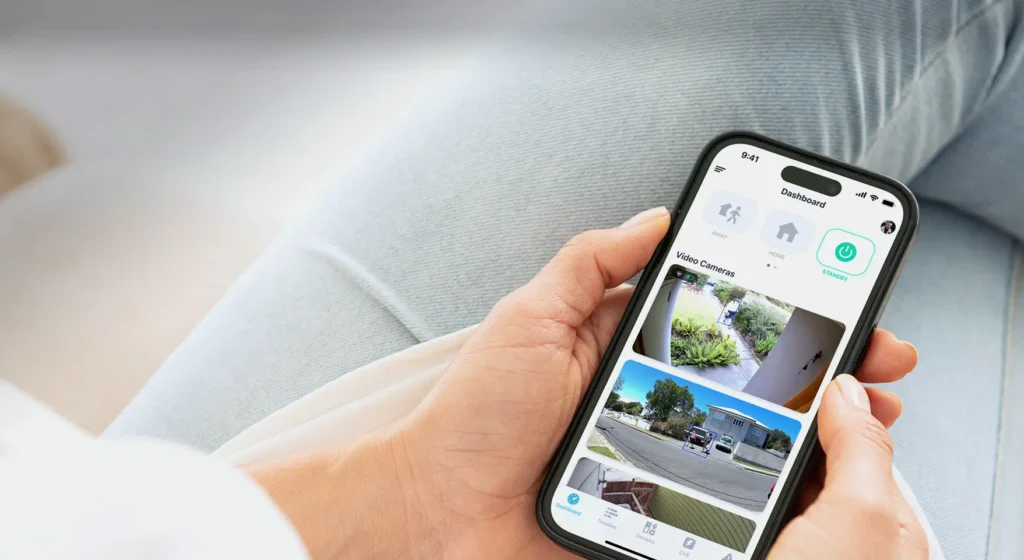
Photo credit: Abode
DIY home security systems, particularly those bundled in starter kits, offer a range of advantages that make them an attractive alternative to professional monitoring:
Affordability: DIY systems often cost significantly less than professional ones, both upfront and over time, as they typically don’t require monthly fees.
Flexibility and Control: You have full control over your system’s setup, customization, and monitoring. You can choose the components you need, add more as you go, and adjust settings to fit your preferences.
Easy Installation and Setup: Most DIY systems are designed for easy installation and setup, often without requiring any special tools or technical expertise.
No Long-Term Contracts: Unlike many professional services, DIY systems don’t lock you into long-term contracts, giving you more freedom and flexibility.
Integration with Smart Home Devices: Many DIY systems can be integrated with other smart home devices like lights, thermostats, and voice assistants, creating a more seamless and convenient home automation experience. For an overview of how this integration works, check out our Smart Home 101: Guide to Connected Living.
Remote Access and Monitoring: You can monitor your home from anywhere using your smartphone or tablet, providing peace of mind even when you’re away.
Why Start with a Starter Kit?
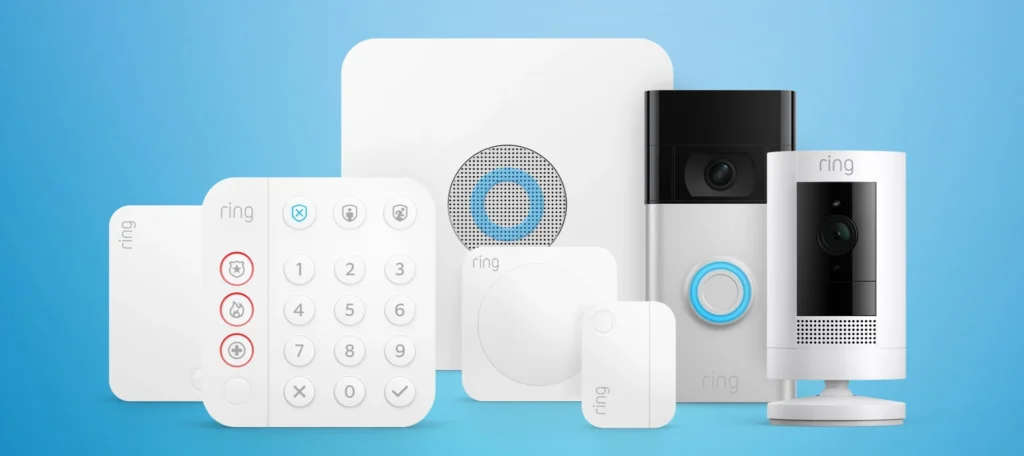
Photo credit: Ring
A DIY home security starter kit is a great way to dip your toes into the world of smart home security. These kits typically include the essential components you need to get started, such as:
- Base Station or Hub: The central control panel for your system, usually with a built-in siren.
- Door/Window Sensors: Detect when doors or windows are opened or closed.
- Motion Sensor: Detects movement within a specific area.
- Keypad or Key Fob: Used to arm and disarm your system.
Starter kits often offer a more cost-effective way to get started than buying each component separately. They are also a great way to test out a system and see if DIY monitoring is right for you before investing in additional components or expanding your system.
DIY vs. Professional Monitoring: Which is Right for You?
The choice between DIY and professional monitoring boils down to your individual needs, budget, and comfort level. Here’s a breakdown of the key differences:
DIY Monitoring
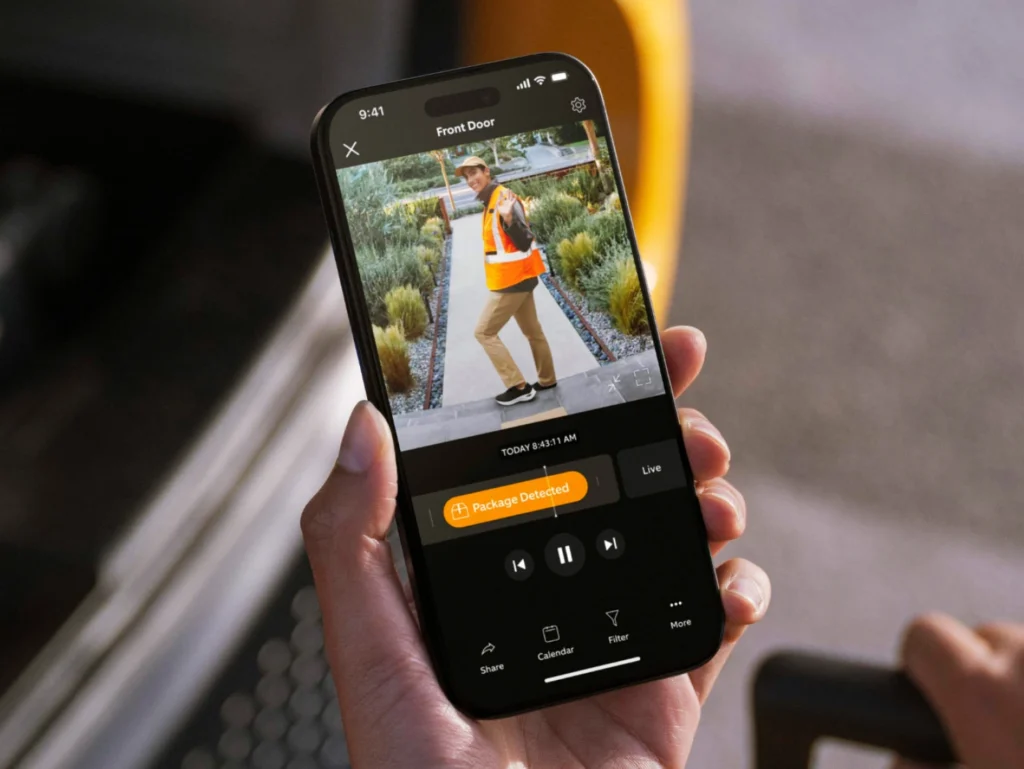
Photo credit: Ring
Pros
- Affordable: No monthly fees, just the upfront cost of the system.
- Control and Flexibility: You have complete control over your system’s setup and monitoring.
- Easy Setup: Most DIY systems are designed for easy installation and setup.
- No Contracts: You’re not tied to any long-term contracts.
- Local and/or Cloud Storage Options: Choose between local storage on a microSD card or hard drive, or cloud storage (often with a subscription fee) for remote access and potential redundancy.
Cons
- No Professional Response (unless you subscribe to a monitoring plan): While the base option is self-monitoring, most DIY systems offer the option to add 24/7 professional monitoring for an additional fee.
- Potential for False Alarms: While some DIY systems can be prone to false alarms, this varies depending on the specific system, sensor quality, and proper installation. It’s important to research the specific system you’re considering and adjust sensor settings as needed to minimize false alarms.
- Customer Support: Primarily relies on online resources and community forums, but some companies offer email, live chat, or phone support.
Professional Monitoring
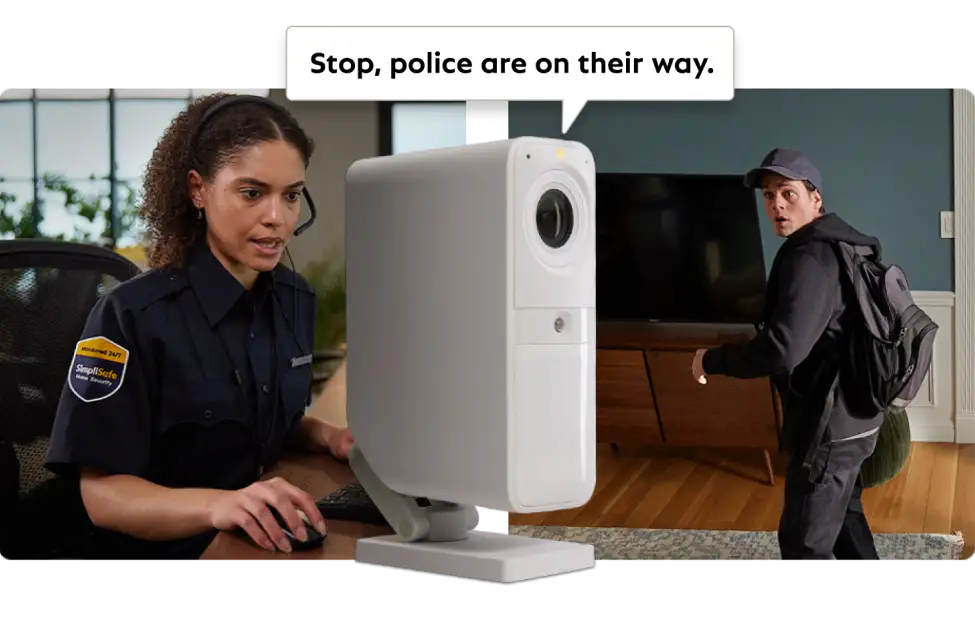
Photo credit: SimpliSafe
Pros
- 24/7 Monitoring: Professionals monitor your system around the clock.
- Immediate Response: In case of an alarm, the monitoring center will contact the authorities.
- Reduced False Alarms: Professional systems typically have measures to reduce false alarms.
- Additional Services: Many companies offer additional services like cellular backup, environmental monitoring, and smart home integration.
- Cloud Storage: Footage is usually stored in the cloud, accessible from anywhere.
- Dedicated Customer Support: Professional systems typically offer phone support and online resources.
Cons
- Monthly Fees: You’ll need to pay a monthly fee for professional monitoring.
- Contracts: You may be required to sign a long-term contract.
- Less Control: You have less control over your system’s setup and monitoring compared to a DIY system.
Hybrid Options: Some DIY systems offer optional professional monitoring, providing flexibility and a middle ground between the two approaches. This lets you start with DIY monitoring and upgrade if needed.
Making the Decision
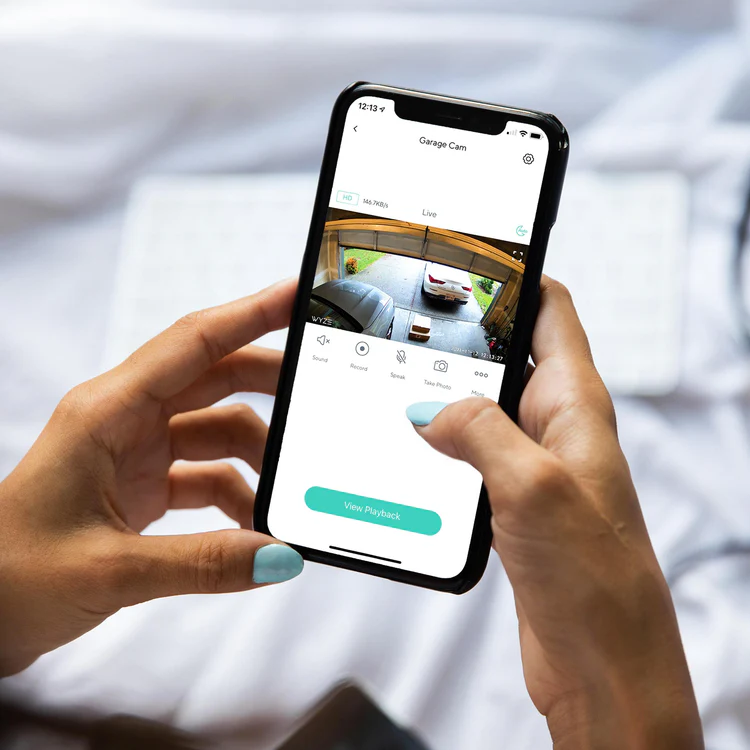
Photo credit: Wyze
Consider the following factors when deciding between DIY and professional monitoring:
- Budget: If cost is a major concern, DIY monitoring is significantly more affordable.
- Comfort Level: If you’re comfortable with basic self-monitoring and responding to alerts, DIY monitoring is a good starting point. If you prefer the peace of mind of 24/7 professional monitoring, many DIY systems offer this as an add-on service for an additional fee.
- Security Needs: If you live in a high-crime area or have valuable possessions, professional monitoring may offer greater peace of mind.
- Smart Home Integration: Many DIY systems offer this capability to integrate your security system with other smart home devices. Be sure to check out our Guide to Choosing a Smart Home Platform for tips on selecting the right one for you.
- Storage and Access to Footage: Consider whether local or cloud storage (and the associated costs) is a better fit for your needs.
- Customer Support: If having dedicated customer support is important to you, professional monitoring might be a better choice.
If you’re unsure, starting with a DIY home security starter kit is a great way to test the waters and see if self-monitoring is right for you. You can always upgrade to professional monitoring later if your needs change.
Key Features to Look for in a DIY Home Security Starter Kit
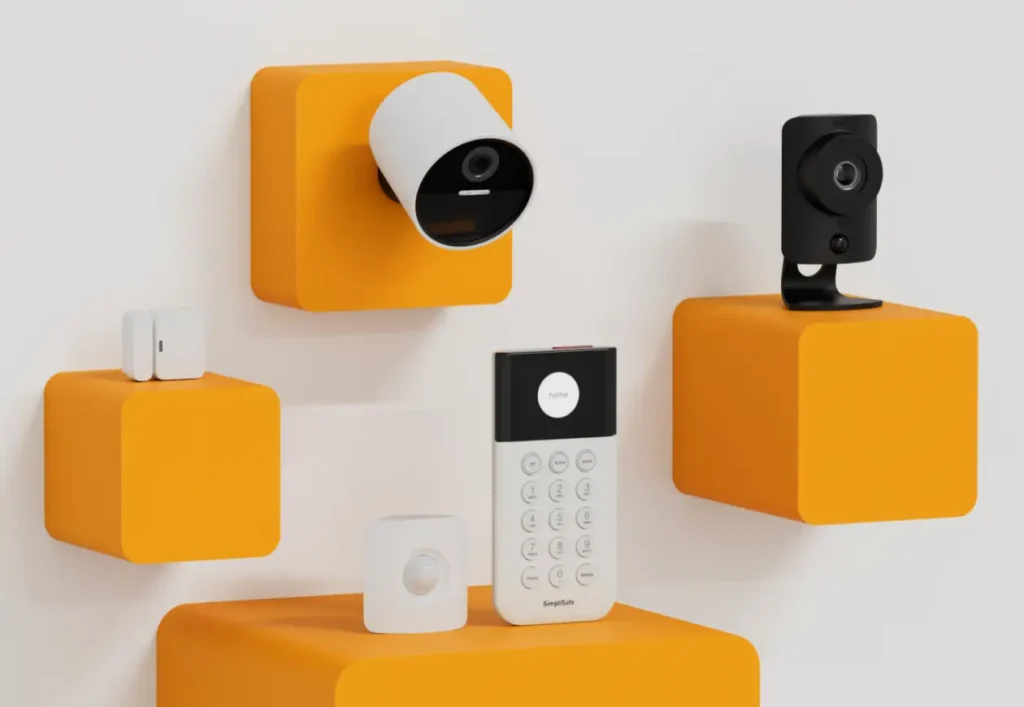
Photo credit: SimpliSafe
With so many DIY home security starter kits on the market, it can be overwhelming to choose the right one. Here are some essential features to consider when making your decision:
Ease of Installation and Use: Look for a system that’s easy to install and set up, even if you’re not tech-savvy. Many kits offer wireless components and user-friendly apps for seamless setup and control.
Essential Components: A basic starter kit should include a base station/hub, door/window sensors, a motion sensor, and a keypad or key fob. Consider your home’s layout and security needs to decide if you need additional components like glass break sensors, smoke detectors, security cameras or video doorbell. For guidance on choosing the right video doorbell, check out our 2024 Video Doorbell Buying Guide.
Smart Home Compatibility: If you have or plan to have other smart home devices, look for a system that’s compatible with platforms like Amazon Alexa, Google Assistant, or Apple HomeKit. This lets you control your security system with voice commands and create automation for added convenience. For help choosing compatible devices, see our Guide to Choosing Smart Home Devices.
Battery Backup: In case of a power outage, a battery backup will ensure your system continues to function. Look for a system with a long-lasting battery backup or consider adding a backup power supply for extended protection.
Local and/or Cloud Storage: Consider whether you want your security footage stored locally (on a microSD card or hard drive) or in the cloud. Cloud storage usually requires a subscription fee, but it offers remote access to your footage and can be more reliable in case of theft or damage to your system.
Subscription Options: Some DIY systems offer optional subscription plans that unlock additional features like professional monitoring, cloud storage, or cellular backup. Consider these options to see if they align with your budget and needs.
Customer Reviews and Ratings: Before making a purchase, research different DIY home security starter kits and read reviews from other users. This can give you valuable insights into the system’s performance, reliability, and ease of use.
Additional Features (Optional):
- Environmental Sensors: Some kits include sensors for detecting water leaks, smoke, or carbon monoxide, adding an extra layer of protection to your home.
- Outdoor Cameras: If you want to monitor your home’s exterior, consider a kit that includes or allows you to add outdoor security cameras.
- Siren: A loud siren can deter intruders and alert you to a potential threat. Look for a system with a built-in siren or the option to add one.
- Geofencing: This feature uses your smartphone’s location to automatically arm or disarm your system when you leave or arrive home.
A Note on Professional Installation: While DIY systems are designed for self-installation, some companies offer professional installation as an add-on service. This can be a good option if you’re not comfortable with the installation process or if you have a complex system with multiple components.
Setting Up Your DIY Home Security System: Tips for Success
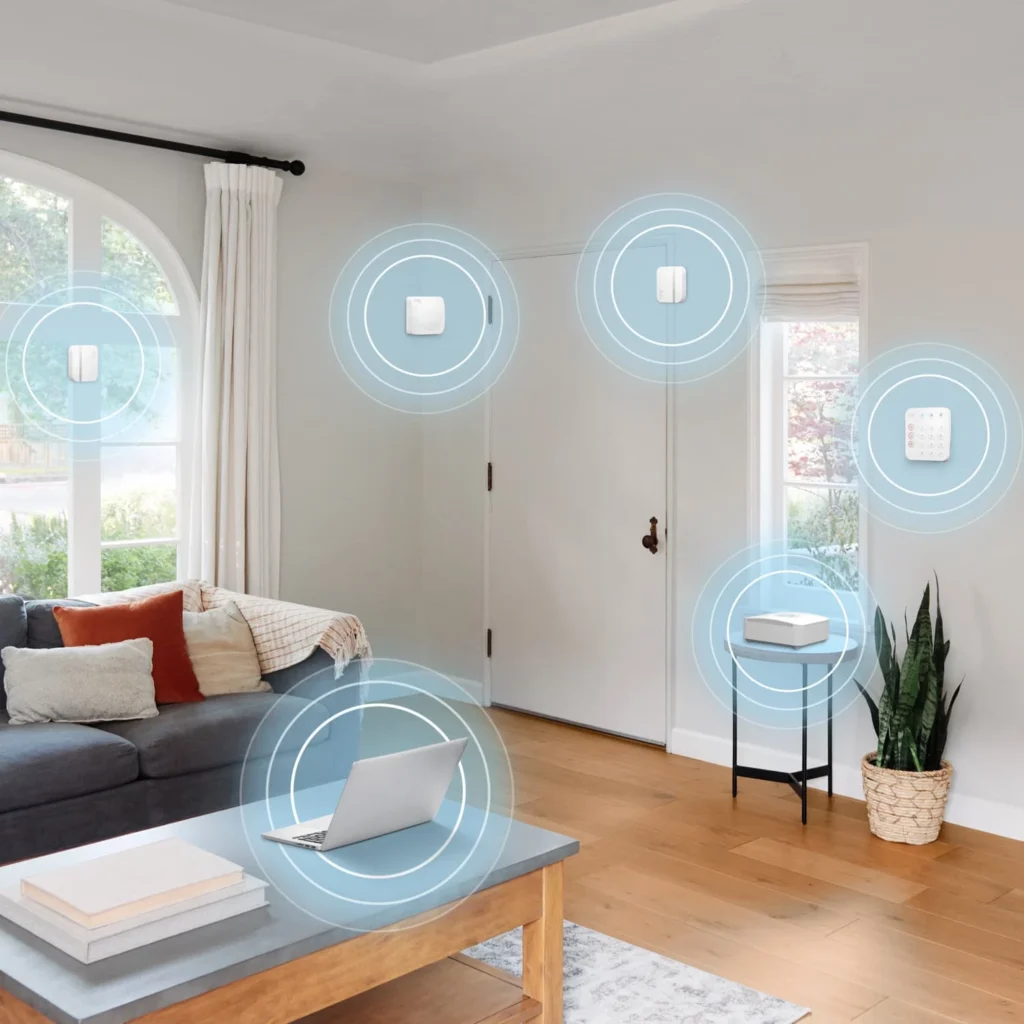
Photo credit: Ring
Setting up your DIY home security system doesn’t have to be complicated. Here are some tips to ensure a smooth and effective installation:
- Plan Your Layout: Before you start, consider the layout of your home and where you want to place your sensors and cameras. Focus on entry points like doors and windows, as well as high-traffic areas.
- Follow the Instructions: Most DIY systems come with clear instructions. Take your time, read them carefully, and follow them step by step.
- Test Your System Thoroughly: After installation, test each component to ensure it’s working correctly. Trigger the sensors and cameras to verify that they send alerts to your app or control panel.
- Secure Your Wi-Fi Network: Since most DIY systems rely on Wi-Fi, ensure your home network is secure with a strong password and up-to-date security protocols.
- Consider a Backup Power Source: To keep your system running during power outages, invest in a backup battery or uninterruptible power supply (UPS).
- Customize Your Settings: Explore your system’s settings to tailor them to your preferences. You can adjust sensitivity levels for sensors, set up alerts for specific events, and create custom automations.
- Regularly Update Software: Keep your system’s software and firmware up to date to ensure optimal performance and security.
- Maintain Your System: Regularly check your sensors and cameras for dust or debris, and replace batteries as needed.
- Get to Know Your App: Familiarize yourself with your system’s app so you can easily monitor your home, arm or disarm your system remotely, and view footage (if you have cameras).
- Educate Your Household: Make sure everyone in your household knows how to use the system and what to do in case of an alarm.
Popular DIY Home Security Starter Kits: A Quick Overview
To help you get started on your DIY home security journey, here’s a quick overview of some popular starter kits available in North America.
The User-Friendly All-Rounder: SimpliSafe
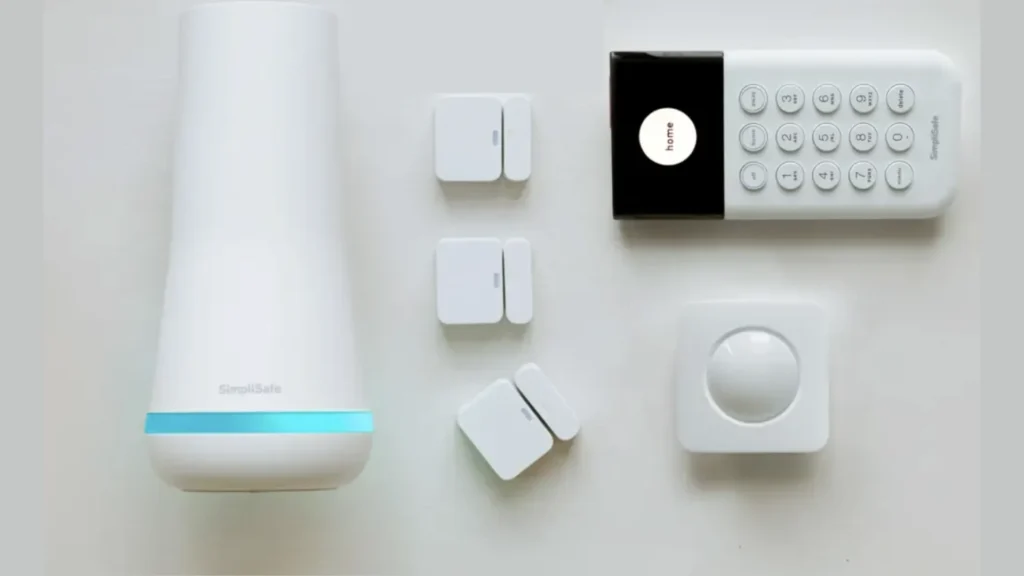
Photo credit: SimpliSafe
Known for its easy setup, sleek design, and intuitive interface, SimpliSafe offers a range of customizable starter kits with optional professional monitoring and installation. It’s a solid choice if you value simplicity and flexibility, with the added bonus of professional monitoring at a competitive price if you decide to go that route.
- Components: Typically includes a base station, keypad, door/window sensors, motion sensor, and key fob. You can also add additional components like cameras, smoke detectors, and panic buttons.
- Smart Home Compatibility: Works with Amazon Alexa and Google Assistant for voice control.
- Storage: Offers both local and cloud storage options (with a subscription fee).
- Pricing: Starter kits range from $150 to $300, with optional professional monitoring starting at $21.99 per month.
Pros
- User-friendly interface and app
- Easy to install and set up
- Variety of customizable kits
- Optional professional monitoring
- Professional installation available
Cons
- Some advanced features require a subscription
- Limited smart home integrations compared to some other systems
Best for Smart Home Integration: Ring Alarm
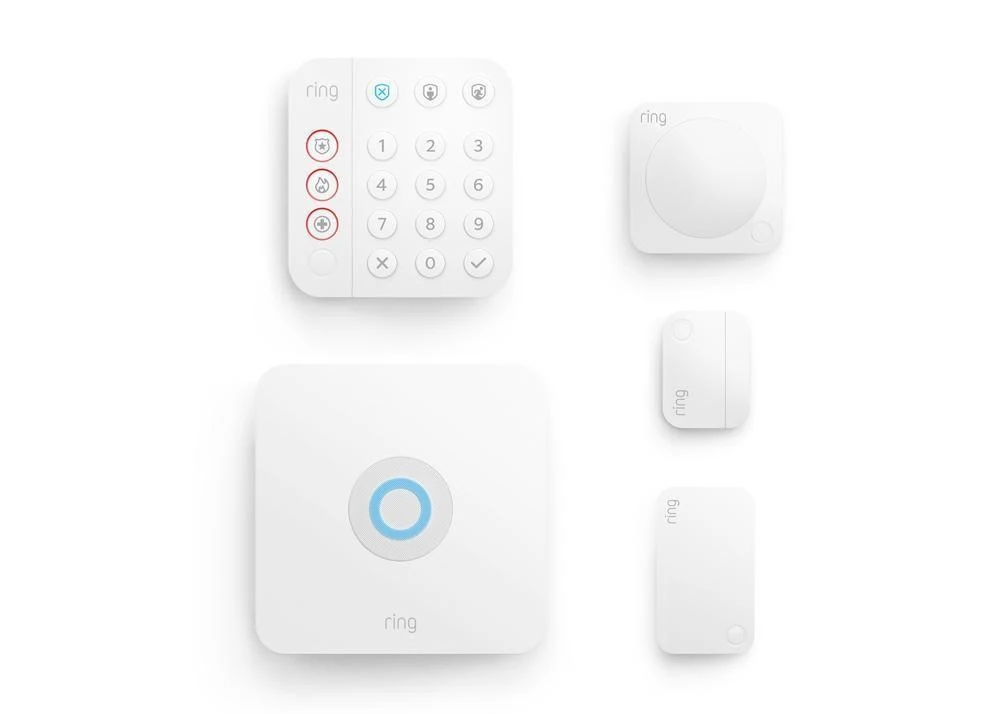
Photo credit: Ring
Ring Alarm is popular for its integration with Ring’s ecosystem of video doorbells and cameras since it all works together seamlessly. You can even mix and match different generations of sensors, so you don’t have to start from scratch. Plus, it works with Amazon Alexa for voice control, and there are a lot of customizable kits to choose from with different smart home devices. So, if you’re thinking about building a whole Ring-powered smart home, Ring Alarm is a great foundation.
- Components: Typically includes a base station, keypad, contact sensors, motion detector, and range extender. You can add Ring video doorbells, cameras, smart locks, and other Ring devices.
- Smart Home Compatibility: Works with Amazon Alexa for voice control and integrates seamlessly with other Ring products.
- Keypad: The Ring Alarm Keypad (2nd Gen) allows for convenient arming/disarming and features dedicated buttons for police, fire, and medical assistance when paired with a Ring Protect Plus subscription.
- Storage: Requires a Ring Protect Plan subscription for video recording and cloud storage (starting at $4.99 per month).
- Pricing: Starter kits (five-piece bundle) start from $200.
- Monitoring Options:
- Ring Protect Basic: Video recording and cloud storage for one device (e.g., doorbell or camera), starting at $4.99 per month or $49.99 per year.
- Ring Protect Plus: Video recording and cloud storage for all devices at your address, plus 24/7 professional monitoring with cellular backup, starting at $10 per month or $100 per year.
- Professional Installation: Ring offers professional installation through OnTech Smart Services for added convenience.
Pros
- Seamless integration with Ring video doorbells and cameras
- Wide range of customizable kits and add-on devices
- Affordable professional monitoring option (with Ring Protect Plus)
- Works with Amazon Alexa
- Convenient keypad with emergency buttons
- Professional installation available
Cons
- Requires a subscription for video recording and some features
- Limited compatibility with third-party smart home devices
Best for Flexibility and Customization: Abode Security Kit
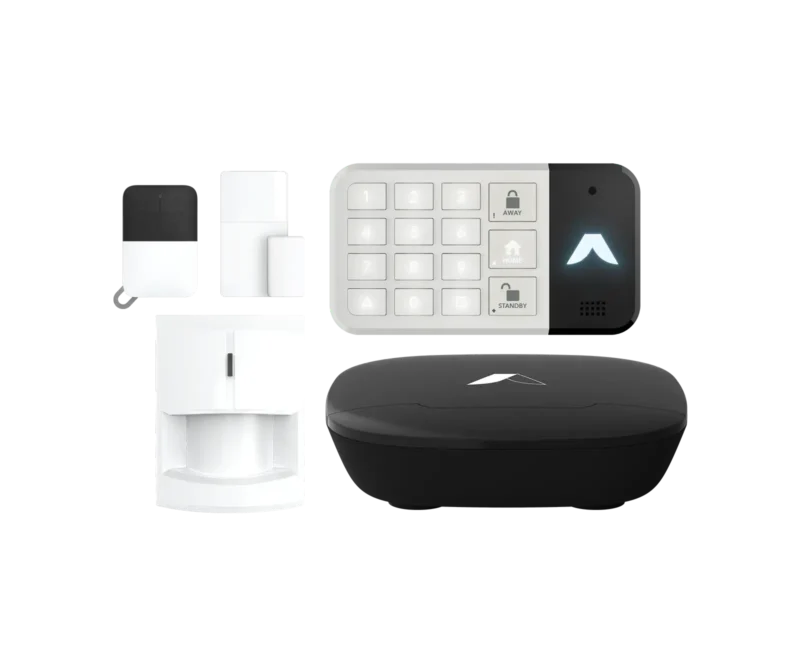
Photo credit: Abode
Abode stands out for its flexibility, offering both DIY and professional monitoring options. It’s also compatible with various smart home platforms and third-party devices. Abode has won awards for its innovative approach to home security, like the CES Innovation Award and the Red Dot Design Award. Take their iota gateway, for instance: it’s an all-in-one device that acts as a hub, camera, motion sensor, and siren, making it perfect for smaller homes or apartments where space is at a premium. Plus, Abode’s Cue automation engine lets you create custom automations based on different triggers, so you can really personalize your smart home security setup.
- Components: Starter kits typically include the Abode iota gateway (all-in-one hub with built-in camera), door/window sensors, and a key fob. It also offers a wide range of add-on devices like motion sensors, water leak sensors, and more.
- Smart Home Compatibility: Abode stands out for its extensive compatibility, working with Apple HomeKit, Amazon Alexa, Google Assistant, Zigbee, Z-Wave, and IFTTT.
- Storage: Offers free local storage on the gateway and optional cloud storage plans for continuous video recording and remote access.
- Pricing: Starter kits for a 5-piece bundle are $179.99 (discounted from $400), with optional professional monitoring plans at $22.99 per month (no contract required).
Pros
- Wide range of compatibility with smart home platforms and devices
- Offers both DIY and professional monitoring options
- No contract is required for professional monitoring
- Flexible and customizable system
- Easy to install and use
Cons
- Starter kits can be more expensive than some other options
- Some features require a subscription plan
Best Budget-Friendly Option: Wyze Home Monitoring Core Starter Kit
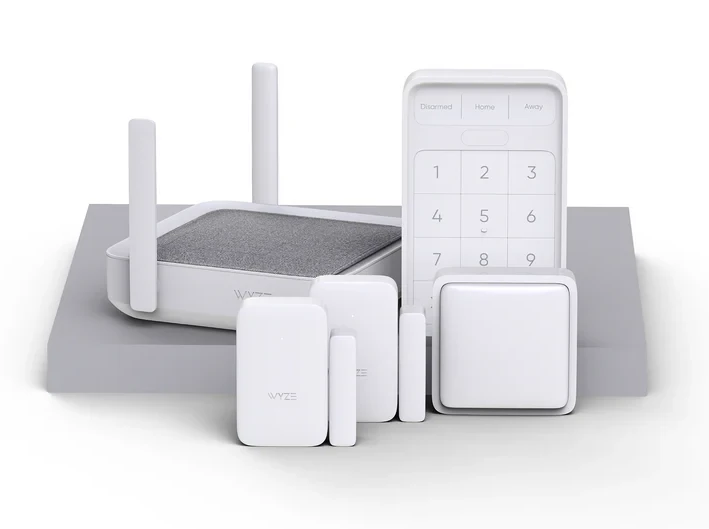
Photo credit: Wyze
If you’re looking for a wallet-friendly option, Wyze is a great choice. They offer a starter kit that won’t break the bank, and it comes with all the basics you need to get started. Plus, you can add cloud storage or professional monitoring if you want. Wyze also has a lot of other affordable smart home devices that work seamlessly with their security system – like cameras, doorbells, smart plugs, and sensors. The Wyze app is super user-friendly, making it easy to keep an eye on things at home and control everything from your phone. You can even sign up for Wyze Cam Plus to get extra features like person detection, package detection, pet detection, and longer video clips.
- Components: The Wyze Home Monitoring Core Starter Kit includes a Sense Hub (base station), a keypad, two entry sensors, and a motion sensor. You can add various Wyze cameras, sensors, and other smart home devices.
- Smart Home Compatibility: Works with Amazon Alexa and Google Assistant for voice control.
- Storage: The base station has a slot for a microSD card (not included) for local storage. Wyze Cam Plus (paid subscription) is required for cloud storage and advanced features like person detection.
- Pricing: Wyze Home Monitoring Core Starter Kit is $79.99 (includes 3 months of professional monitoring). Wyze Cam Plus subscription is $2.99 per month per camera, or Wyze Cam Unlimited for $9.99 per month for unlimited cameras. Professional monitoring costs $9.99 per month or $99.99 per year.
Pros
- Extremely affordable starter kit and devices
- Easy setup and user-friendly app
- Wide range of compatible Wyze cameras and devices
- Optional professional monitoring
- No long-term contracts
Cons
- Basic starter kit, might need additional components for comprehensive security
- Cloud storage and some advanced features require a subscription
- Professional monitoring requires the starter kit
Best Renter-Friendly Option: Kangaroo Front Door Security Kit with Professional Monitoring
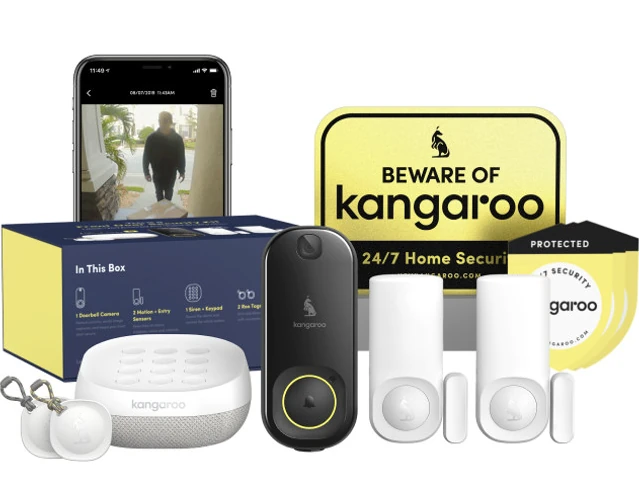
Photo credit: Kangaroo
Kangaroo is a newer player in the home security market, but it’s quickly gained popularity for its simple, affordable, and renter-friendly systems. It’s a hit with both users and tech experts, known for being incredibly easy to set up, requiring no tools for installation, and featuring a renter-friendly design that doesn’t need any drilling. Plus, it offers a range of affordable, modular devices that you can mix and match to fit your needs.
- Components: The Front Door Security Kit includes a base station, keypad, two entry sensors, motion sensor, and yard sign. You can add other devices like a siren, smoke detector, water leak sensor, and more.
- Smart Home Compatibility: Works with Amazon Alexa and Google Assistant for voice control.
- Storage: Offers free local storage for events and optional cloud storage with a subscription (Kangaroo Complete) for continuous video recording and other features.
- Pricing: The Front Door Security Kit costs $279 and includes a year of professional monitoring (Kangaroo Complete). Individual devices are also available for purchase, starting at $29.99. After the first year, Kangaroo Complete costs $99 per year.
- Privacy Camera: It features a unique polymer dispersed liquid crystal (PDLC) glass that creates a physical barrier when the camera is turned off.
Pros
- Extremely easy to install and set up (no tools required)
- Affordable starter kits and devices
- No contract required
- Modular system, allowing you to add devices as needed
- Renter-friendly design (no drilling required)
- Offers 24/7 professional monitoring
Cons
- Limited smart home integrations compared to some other systems
- More basic features compared to some other systems
Your DIY Home Security Journey Starts Now
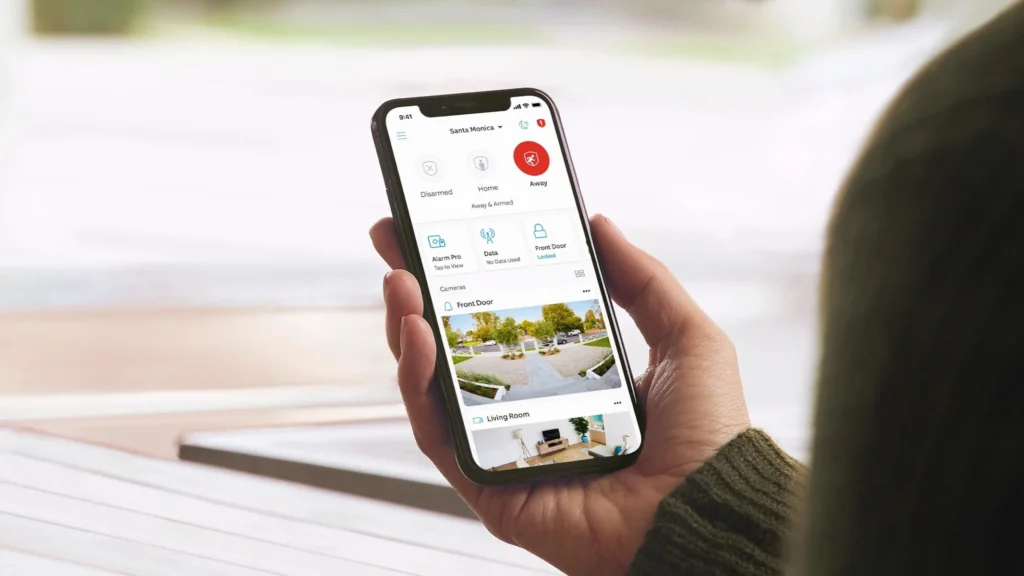
Photo credit: Ring
Choosing the right DIY home security system is a personal decision, but with the information in this guide, you’re well-equipped to make an informed choice. Whether you prioritize affordability, ease of use, smart home integration, or professional monitoring, there’s a starter kit out there that’s perfect for you.
Remember, start small and expand your system over time as your needs evolve. Explore the different DIY home security options available, read reviews, and choose the system that best suits your lifestyle.
For a glimpse into the future of home security and automation, check out our article on Smart Homes 2.0: Future of Home Technology.
Additional Tips
- Consider Professional Monitoring: Even if you start with a DIY system, consider adding professional monitoring for an extra layer of security, especially if you travel frequently or have valuable possessions.
- Secure Your Wi-Fi Network: A strong password and up-to-date security protocols will help protect your smart home devices from hacking.
- Read Reviews: Before purchasing, research different brands and read reviews from other users to get insights into their experiences.
- Don’t Hesitate to Ask for Help: If you’re unsure about any aspect of DIY home security, don’t hesitate to ask for help from friends, family, or online communities.
By taking these steps, you can create a secure and smart home that gives you peace of mind and protects what matters most.
FAQs
Are DIY home security systems as reliable as professional ones?
DIY systems can be just as reliable as professional ones, but it depends on the quality of the system and the components you choose. Research different brands, read reviews, and choose a system with a good reputation for reliability and performance.
Can a DIY home security system help me save on my home insurance?
Yes, many insurance companies offer discounts for homes with security systems, even if they’re DIY. Contact your insurance provider to see if you qualify for a discount.
What happens with my DIY home security system if my Wi-Fi goes down?
Most DIY systems have a cellular backup option, often as part of a professional monitoring plan, that will keep your system connected even if your Wi-Fi is down. Some systems also have battery backups to keep them running during power outages.
What’s the difference between local and cloud storage in a DIY home security system?
Local storage saves footage on a microSD card or hard drive within the system, while cloud storage saves it on remote servers. Cloud storage often requires a subscription fee but offers remote access and may be more reliable in case of theft or damage to your system.

